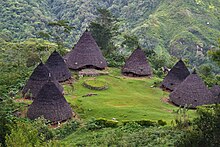
Mbaru Niang is a Manggarainese traditional house in Waerebo, Satar Lenda Village, Satar Mesa District, Manggarai Regency.

Mbaru Niang is a Manggarainese traditional house in Waerebo, Satar Lenda Village, Satar Mesa District, Manggarai Regency.
The name mbaruniang consists of two words, mbaru and niang. The word mbaru means house, while the word niang means tall and round. This name represents the form of mbaru niang, a cone tapering upwards. The form of mbaru niang is interpreted as a Manggarainese life philosophy in Wae Rebo. The Manggarainese believe that balance is represented by a circle. Thus, the shape of houses and the layout of villages constructed by the Manggarainese follow circular patterns. [1]
Mbaru Niang is built with seven houses arranged in a circular shape on flat land. In the middle of the circle, there is an altar called compang. Compang is the central point of the seven Mbaru Niang houses, and it is the most sacred location for the Manggarainese in Wae Rebo. The compang altar is used to worship God and ancestral spirits. [1]
Mbaru Niang is located in the traditional settlement of the Manggarai people in Waerebo, Satar Lenda Village, Satar Mesa District, Manggarai Regency. The location of Waerebo Village is at coordinates 8°46'8.88" South Latitude and 120°17'1.81" East Longitude. It is situated at an altitude of 1,120 meters above sea level on the slopes of Gonto Ponto, which reaches a height of 1,782 meters above sea level. [2]
The old design of mbaru niang only consists of one door without windows. The door is located at the front and serves as both an entrance and exit. Mbaru Niang's interior was very dark due to the absence of windows. However, the conditions inside the old Mbaru Niang are unknown because of the lack of information. It is estimated that there were no separate bedrooms for each family in the old design. This is because the number of inhabitants in the mbaru niang reached hundreds, so it is assumed that they only slept on the floor. There was only one empty space in the old design of mbaru niang and no rooms. The function of this empty space was for sleeping, eating, and discussions. [3]
The construction process of mbaru niang by the ancestors began with a traditional ceremony. After that, building materials were prepared from the surrounding forests of Waerebo to construct the seven houses. The building materials used include majegau wood, boards made of Indonesian mahogany wood, wooden blocks made of Bolly beech wood, and roofs made of lontar palm leaves and fibers. The roofs were built from the top downward until they almost touched the ground. The seven buildings were a form of respect for the seven-point directions from the seven mountain peaks surrounding Waerebo. [4]
The old design of mbaru niang is considered the original form of mbaru gendang of the Manggarainese. Before the 1960s, the old design of mbaru niang was still commonly found in Manggarai. However, Manggarai people began to change the house style after that decade. Only mbaru niang, located in Todo and Wae Rebo, are preserved. However, the mbaru niang in Todo has undergone renovations several times. Meanwhile, part of the mbaru niang in Waerebo collapsed in the 1990s. [5]
In 2008, the Indonesian Architecture team noted that there were only four remaining mbaru niang in Wae Rebo. Meanwhile, according to the villagers, there were originally seven houses. The Indonesian Architecture team then conducted conservation efforts on the mbaru niang buildings. After the conservation efforts, the number of mbaru niang returned to seven. Each mbaru niang was given a name: Niang Gendang, Niang Gena Mandok, Niang Gena Jekong, Niang Gena Ndorom, Niang Gena Keto, Niang Gena Jintam, and Niang Gena Maro. Niang Gendang became a drum storage warehouse. The other mbaru niang belonged to each clan in Waerebo. [6]
The mbaru niang was then constructed into six vertical levels. Each floor, from bottom to top, was named Ngaung, Tenda, Lobo, Lentar, Lempe Rae, and Hekang Code. Ngaung serves as the base of the mbaru niang building. Its function includes weaving, crafting, and storing gardening tools. Tenda is the first floor of the mbaru niang, serving as the main area for residents to conduct various activities. Next is Lobo, the second floor within the mbaru Niang, designated for storing food supplies. Lentar is the third floor inside the mbaru niang, functioning as storage when crop failure occurs. The fourth floor is Lempe Rae, exclusively used for seed storage. Meanwhile, the highest floor of the mbaru niang is called Hekang Code. Inside Hekang Code, there is only an ancestral altar. This floor is only used during building dedication ceremonies. [7]
The mbaru niang uses traditional building technology based on binding methods rather than nails. Because it does not use nails, there is a lack of rigidity in the mbaru niang structures. This condition results in more flexible and resilient buildings that can withstand the shaking caused by earthquakes. [8]
Mbaru niang's traditional house is considered extremely rare because it is only found in Waerebo. Efforts to conserve mbaru niang received the highest recognition in the cultural heritage conservation category from UNESCO Asia Pacific in 2012 and became one of the candidates for the Aga Khan Award for Architecture in 2013. [9] [10]

Malay houses refer to the vernacular dwellings of the Malays, an ethno-linguistic group inhabiting Sumatra, coastal Borneo and the Malay Peninsula.

The Istana Budaya or also known as the Palace of Culture, is Malaysia's main venue for all types of theatre including musical theatre, operetta, classical concerts and opera from local and international performances. It is located in the heart of Kuala Lumpur city, next to the National Art Gallery.

Joglo is a type of traditional vernacular house of the Javanese people. The word joglo refers to the shape of the roof. In the highly hierarchical Javanese culture, the type of roof of a house reflects the social and economic status of the owners of the house; joglo houses are traditionally associated with Javanese aristocrats.

The Manggarai are an ethnic group found in western Flores in the East Nusa Tenggara province, Indonesia. Manggarai people are spread across three regencies in the province, namely the West Manggarai Regency, Manggarai Regency, and East Manggarai Regency.

Labuan Bajo is a fishing town located at the western end of the large island of Flores in the East Nusa Tenggara province of Indonesia. It is in Komodo district. It is the capital of the West Manggarai Regency, one of the eight regencies of Flores.

Batak architecture refers to the related architectural traditions and designs of the various Batak peoples of North Sumatra, Indonesia. Six groups of Batak speak separate but related languages: the Angkola, the Mandailing to the south, the Toba, to the north the Pakpak/Dairi, the Simalungun, and the Karo. While the groups are now Muslim or Christian, elements of the ancient Batak religion remain, particularly amongst the Karo.

Rumah adat are traditional houses built in any of the vernacular architecture styles of Indonesia, collectively belonging to the Austronesian architecture. The traditional houses and settlements of the several hundreds ethnic groups of Indonesia are extremely varied and all have their own specific history. It is the Indonesian variants of the whole Austronesian architecture found all over places where Austronesian people inhabited from the Pacific to Madagascar each having their own history, culture and style.

Manggarai Station (MRI) is a railway station at Manggarai, Tebet, South Jakarta, Jakarta, Indonesia. At present, it serves primarily as a transit station for KRL Commuterline's Bogor Line, Cikarang Loop Line, and Soekarno–Hatta Airport Rail Link; The Bukit Duri depot is located at the south side of the station, it also serves as a storage for intercity trains before they go to Gambir or Jakarta Kota stations for their departure.

A bolon house is a Northern Sumatra traditional house in Indonesia. Bolon houses are also tourist objects in Northern Sumatra. Bolon houses are made with wood. The house floor is made with boards. The roof is made with rumbia leaves. Bolon houses have no individual rooms, but the space inside is divided. There is space for the house leader, for family meetings, for daughters who have married but have no house of their own, and for the oldest son who has already married. This space is influenced by Batak culture. In ancient times, bolon houses used to be the place where 13 kings of Batak lived. Today, only a few bolon houses can be found in North Sumatra.
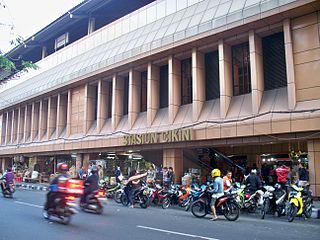
Cikini Station is a railway station located on Jl. Cikini Raya, Cikini, Menteng, Jakarta. This station is only served by KRL Commuterline commuter trains from Jakarta Kota to Depok and Bogor.
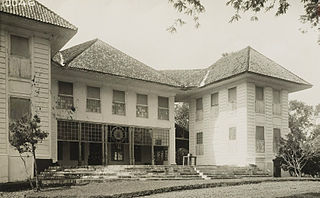
Tandjong Oost, also known as Groeneveld, was a particuliere land, or private domain, in modern-day Pasar Rebo, East Jakarta, Indonesia. It was one of two estates located on the banks of the Ciliwung river: Tandjong Oost to the east of the river, and Tandjong West to the west.

Rangkiang is a granary or rice barn that the Minangkabau people used to keep rice in. The rangkiang is a distinctive feature of Minangkabau architecture. The structure is traditionally found in the courtyard of a rumah gadang, the traditional house of Minangkabau people.
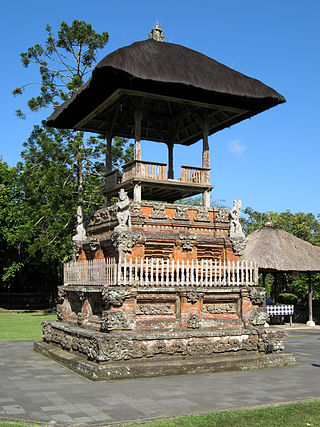
The bale kulkul or bale kul-kul is a Balinese pavilion where a slit-log drum is placed. It is essentially a drum tower or a watch tower. A bale kulkul can has a civic function, such as those used in villages as a mean of communication; or for religious function, an integral part of Balinese temple architecture.

Rao Rao Mosque is one of the oldest mosques in Indonesia located in Nagari Rao Rao, Tarab River, Tanah Datar Regency, West Sumatra. It is located on the road from Batusangkar bound to Bukittinggi, precisely in Rao Rao. This mosque of Minangkabau and Persian architecture was built in 1908 with a roof made from fibers before being changed to zinc.

Rumah limas, also known as rumah bari, is a type of traditional house found in Palembang, South Sumatra, Indonesia. It can also be found in Baturaja. The house is traditionally made of wood and raised on stilts, with a stepped, or gradated, floor composed of two to five areas at slightly different heights, a broad porch, and a distinctive roof. In Palembang, these houses are associated with the nobility and other people of high status.

Rumah ulu is a vernacular house found in the highlands of South Sumatra, Indonesia. The house is associated with the Uluan people, who reside in the region upstream of the Ogan and Musi rivers.
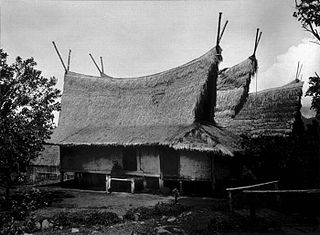
Sundanese traditional house refers to the traditional vernacular houses of the Sundanese people, who predominantly inhabited the western parts of Java island, Indonesia. The architecture of a Sundanese house is characterized by its functionality, simplicity, modesty, uniformity with a little detail, its use of natural thatched materials, and the quite faithful adherence to harmony with nature and the environment.

CSW-ASEAN TOD is a public transit interchange station and transit-oriented development zone between four TransJakarta BRT stations and the ASEAN MRT station on the old Centrale Stichting Wederopbouw or CSW intersection at Kebayoran Baru, Jakarta, Indonesia. This building is a circular crossing bridge with an art-deco architecture that connects four Transjakarta BRT stations located to the west, east and south of the intersection and the ASEAN MRT station to the north of the intersection. This building began to open on December 22, 2021 as an operational trial for the integration of integrated highway bus services and integrated highway modes.
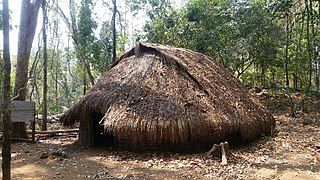
Bunong house (ផ្ទះឞូន៝ងពីបុរាណ) are circular straw houses built by the Bunong people in Cambodia and Vietnam.

Waerebo or Wae Rebo is a village situated in the Manggarai Regency, East Nusa Tenggara. Located at 1,200 meters above sea level, the village is composed of 7 main houses, known as Mbaru Niang. In 2012, it was given Cultural Heritage Conservation status by UNESCO Asia Pacific. It is one of the cultural tourism destinations in Manggarai Regency, Indonesia.